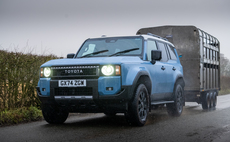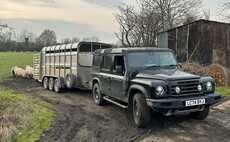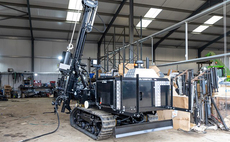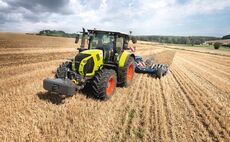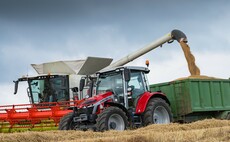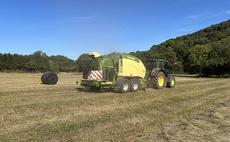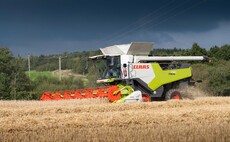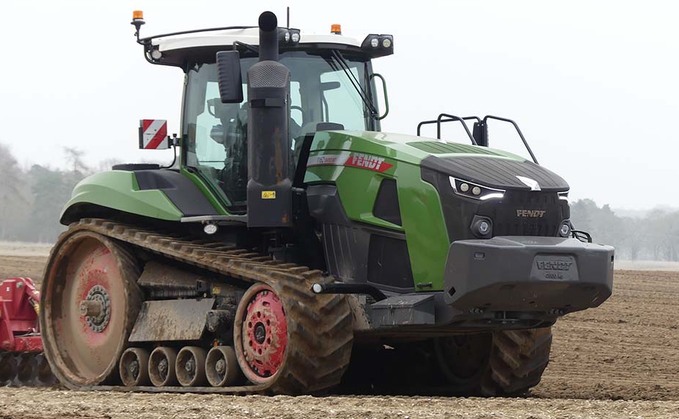
Aiming to find out more about Fendt's latest tracked tractor development, we try out a model from its new large frame 1100 Vario MT Series. James Rickard reports.
Following on from the development of its small framed 900 Vario MT range of tracked tractors, Fendt has now turned its attentions to its large framed machines and given them a significant overhaul.
It may be recalled that Fendt effectively inherited a range of tracked tractors for the European market, when parent company Agco decided to merge all the Challenger-branded products into the Fendt camp.
In terms of Fendt-branded tracked tractors, this began about two years ago with the redevelopment of the Challenger MT700 Series, which became the Fendt 900 Vario MT Series, complete with new track units, undercarriage, cooling package, cab layout and continuously variable transmission (CVT).
But while Fendt worked its magic on the smaller framed models, the larger framed models only got a paint job. That is up until now, with the introduction of the new 1100 Vario MT Series. And like the 900 MT Series, it gets several major developments, not least a new engine and transmission.
As before, the new large frame series consists of four models - 1151, 1156, 1162 and 1167 - but with a hike in power which now spans 511-673hp.
To get a flavour of the new series, we tried out the 1162 Vario MT hooked up to a Keeble Brothers Progressive tine/disc cultivator, working 400mm deep into some medium loam soils.
Engine
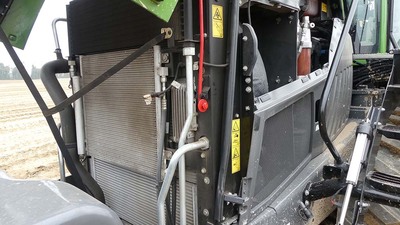
When it comes to power, Fendt has looked outside the Agco stable for the 1100 Series and opted for six-cylinder MAN engines, rather than use the V12 Agco Power units as previous. While this dramatically reduces your bragging rights down the pub, the new motors do bring a significant increase in performance.
The range uses two engine sizes; 15.2-litre motors for the three smallest models and a 16.2-litre engine for the flagship 1167 model. As with the introduction of the 1000 Series wheeled tractors, then subsequently the 900 Series tracked tractors and 900 Series wheeled tractors, the new 1100 MTs use the same low-revving, high torque engine philosophy.
Compared to the V12, the biggest payback comes from the improved torque characteristics, with maximum torque available between 1,100 to 1,450rpm. On an 1167 MT, peak torque is a massive 3,100Nm, while maximum revs is a lowly 1,700rpm on all models.
For us, our test model had no issues cruising at a working speed of 10kph, at which engine revs rarely popped above 1,500rpm, save for the most compacted areas of the field.
As for cooling, unlike the 1000 Series wheeled tractors and 900 MT tracked tractors which use a push-type arrangement, the 1100 MTs use a more conventional pull-type cooling package. In addition, behind the fan is a shield which deflects heat which is drawn through the radiators, out the sides of the bonnet, rather than blowing hot air over the engine and up towards the cab. This also keeps the engine bay cleaner as it is not covering it in dust which can settle.
Service intervals have increased by 100 hours over the V12, to 500 hours, which should bring it inline a little better with the rest of your fleet.
Transmission
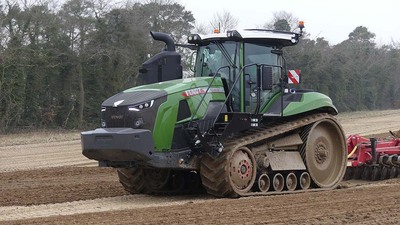
The most fundamental change to the tractor is the transmission, which sees the old powershift ousted in favour of a Fendt Vario CVT.
In principal, it works the same way as the 900 Series tracked machines, comprising a single pump and two motors. During operation in the field, for low speed/high torque applications, both motors are engaged, providing full power to the drive wheels. As the tractor speeds up, one motor gradually ‘swings' towards its neutral position, and at roughly 25kph this motor will be completely disengaged. From this point, only one motor is needed for higher speeds, reducing drag losses in the transmission and therefore boosting efficiency.
Once the tractor's top speed of 40kph has been reached, the remaining motor also swings into neutral, with drive to the rear axle done fully mechanically. From an operator's perspective, all this happens automatically with no need for any range change to be made, as is still the case in the 500, 700 and 800 Series machines.
While some people may be sad to see the loss of a powershift in this tractor, as we have found with other larger tractors which have adopted a CVT, such as Case IH's Quadtrac CVX, the new transmission just transforms the 1100 MT Series tractors. Whether a good or bad thing, it certainly takes a lot less skill and effort to drive - all you do is tell it what speed you want and it works out the rest.
And because it is a CVT, there is no clunking of gears which makes it more comfortable over long days, not just on the operator, but also on the machinery with no sudden jolts through drivelines or drawbars.
However, as the transmission is rated to 600hp, not all of the 1100's power can be put to the ground, particularly with the flagship 1167 MT. While it has got 50hp more than 1162 MT, it can only send the same amount of power to the drive wheels. As such, this ‘spare power' is for customers which really want to make the most of the tractor's ancillary systems, such as pto and hydraulics. Therefore, if you only want the tractor for simpler drawbar-only work, then it is worth bearing in mind that the 1162 could be the more sensible option.
Track units and undercarriage
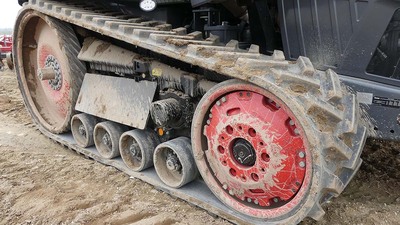
As for the track units, subtle changes have been made to the mid-rollers, which have increased in diameter from 355mm to 380mm. These are now the same as used on the 900 MTs, with the larger diameter allowing the rollers to run at a slower rotational speed, reducing heat build-up. Likewise, mid-roller coating has also been changed from rubber to polyurethane, reducing heat build-up and UV degradation, increasing durability.
To ease maintenance, the ‘snap-in' ring, behind the mid-roller, has now been designed as a failsafe component. Should it fail, the mid-wheel can be removed and the failed snap-in ring replaced, without having to scrap a full and expensive cast assembly.
As for the ‘hard bar' which runs from one side of the machine to the other, providing suspension, this has now been improved by swapping the old rubber ‘marshmallow' for a pair of springs and dampers. Called SmartRide, this was introduced on the 900 MTs and offers a much better cushioning action, both on the road and in the field.
The suspension is also complimented by a new option, SmartRide+, which, via two hydraulic cylinders, helps level the machine. This is especially useful for trying to balance out loads on the tractor, often created by an implement on the rear. As a result, the tracks can be kept much flatter on the ground, increasing traction and making more use of the suspension system.
Because the new transmission is lighter than the previous generation, it means ballasting options are a little bit more flexible. Un-laden, the tractor is about 18.8 tonnes and can be weighted up to just shy of 27 tonnes.
As well as wafer weights, ballasting options for the nose include a two tonne mono-block, which can either be bolted straight on, or a frame can be used to attach it. If the latter, the adjustable suspension can then be used to lower the tractor and allow attachment. However, the frame for this is not available as an option. Instead, the factory is looking into releasing the drawings for this, enabling a customer to get a frame made up.
Other ballasting options include the placing of weights on the idlers, track frame and rear drive wheels (if three point linkage is not specified).
Rear-end
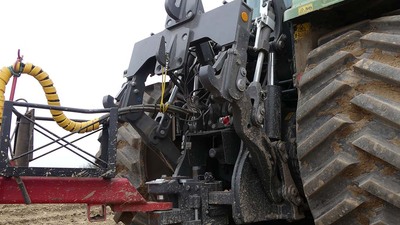
Round the back, several changes have been made. As standard, the tractor is available with a free swinging, category 5 drawbar, offering 28 degrees of side to side movement. A pin can then be used to lock it in one of several positions.
As for the connection point of the drawbar underneath the tractor, this has been moved further forwards by about 80mm, putting it closer to the pivot point of the tractor. This affords an easier, more natural pull of implements with less resistance placed on the tractor. This is particularly noticeable when working, allowing the tractor to make small steering adjustments with less effect on the implement.
Another option is a hydraulically controlled swinging drawbar. While this was available on the Challenger models, this is now much more controllable, which can also be automated. Via the in-cab terminal, the swinging range of the drawbar can be limited, the ability to swing can be automatically turned on or off and the drawbar can be offset. The latter is useful for compensating for implement ‘crab', and when you come to turn on the headland, the drawbar will automatically return to a central position, giving you more room to turn. All this can be automatically triggered using the headland management system.
In addition, a three-point linkage can be specified, which can also be hydraulically steered giving 12 degrees of linkage movement. With this set-up, the drawbar is able to freely swing through a range of 11.5 degrees. Add this swinging drawbar movement to the range of movement from the linkage and you effectively get 23.5 degrees of drawbar movement.
Cab and controls
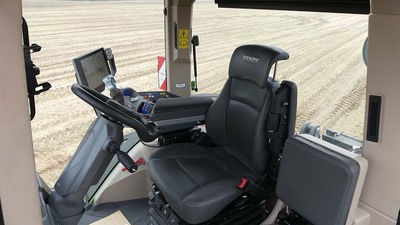
Up top, the cab has also come in for a bit of Fendt treatment. While it still uses the same cab frame as the Challenger days, inside it gets the Bavarian manufacturer's familiar set of controls and layout.
However, customers will have to wait a little longer before this range of tractors gets the firm's new FendtOne layout and have to make do with the current interface. This said, compared to what was in the Challenger models, it is a step up which should make it more appealing to potential customers and provide much more of a familiar place for Fendt operators.
In terms of operation, it is exactly the same as any other Fendt tractor and now features extra guidance features such as the firm's Contour Assist and Turn Assist functions. The latter carries out the whole headland sequence and turning for you, offering several turning options such as bout skips and part field mode.
To activate a turning sequence, this can be done manually, by linking it in with a headland management sequence which you have to activate, or automatically, by setting up a headland boundary which automatically triggers the turning sequence. By doing the latter, the system will calculate how many turns it takes to complete the field and will tell you if there are any turns it cannot make, such as when working into a tight corner which needs a shunt.
As yet, the system cannot work out the most efficient route to take in the field, with the operator still required to set-up an A-B line. However, we are told this is something the manufacturer is looking into.
For extra comfort, the cab can now be specified with mechanical cab suspension. Similarly, various seats can be chosen from, with a heated and cooled leather seat sitting at the top of the options list.
Verdict
Compared to the previous 1100 MT, which only featured a new paint job, the new 1100 Vario MT is now very much a Fendt product.
In particular, the introduction of a CVT truly brings it into the Fendt family. Some might be sad to see the powershift go, particularly in other parts of the world where pretty much one gear will do the job all day, however, the new CVT brings with it many benefits.
In addition, the changes to the track suspension system makes the ride a lot smoother, both in and out of the field.
On the downside, surely Fendt could have created a front weight frame which it could offer as an option, rather than getting its customers to build their own.
Overall though, Fendt has done well to marry the 30-plus years of Challenger tracked tractor experience with its CVT and technology knowhow.


















